
Original Link: https://www.anandtech.com/show/2131
OCZ Flex XLC: PC2-9200 Pushes the Envelope
by Wesley Fink on December 8, 2006 8:00 PM EST- Posted in
- Memory
The memory market has been rather routine lately. After the introductions of AMD AM2 and Intel Core 2 Duo memory was a unified solution again - with both camps supporting DDR2. Micron had the best chips, as they have almost since the first DDR2 DIMMs became available, and the top of the memory heap could do DDR2-1067 to DDR2 1100 at spectacular 4-4-3 timings and the more mainstream DDR2-800 at 3-3-3 timings. The best memory was expensive, at about $400 to $500 for a 2GB kit, and the mid and value performed almost as well, but at about half the price.
Buyers have shopped for a value/mid memory solution if cost was a big concern. With memory bandwidth not making a huge difference in performance on either the C2D or AM2 solutions, many were not willing to invest in the best memory available. Those who did want the best could choose from Corsair, OCZ, Mushkin, Patriot, Team, G.Skill, Kingston, Geil, and Super Talent but there was very little to distinguish between the top performers. Perhaps a company might have done a better job of binning chips for the high-end, but the real differences were small and they mostly looked the same - different-colored heatspreaders combined with some variations on how to build a heat-spreader that stood out from the crowd.
Enter OCZ with a new idea - memory with built-in water blocks. OCZ Flex XLC is built for record-setting performance in regular air cooling, with the option to cool with water when you want even more. It is sold with the heatsinks and nipples to connect water-tubing and it is aggressively binned to provide unheard of performance levels in overclocking - on either air or water.
The new OCZ solution certainly looks impressive, but AnandTech readers are used to pretty packages. The real question is whether OCZ Flex XLC delivers the performance it promises. Does OCZ's bold new approach deliver the record-setting performance it promises?
OCZ PC2-9200 Flex XLC Specifications
OCZ is a well-known supplier of enthusiast parts. While they are best known for their memory targeted at the enthusiast, OCZ also provides an extensive line of power supplies and CPU coolers, along with more value oriented memory. As recently seen in Taiwan, OCZ also plans to introduce custom water-cooling parts in 2007. With that in mind, the OCZ introduction of water-cooling ready enthusiast memory appears to fit the total picture.
OCZ tells us that then new Flex XLC memory is not designed just for water-cooling. In fact, with air-cooling alone Flex XLC can reach most of its potential. It is designed to be the fastest memory available from OCZ whether run on air or water. One thing that is clear is that Flex XLC does not look like other high-end DDR2 memory.
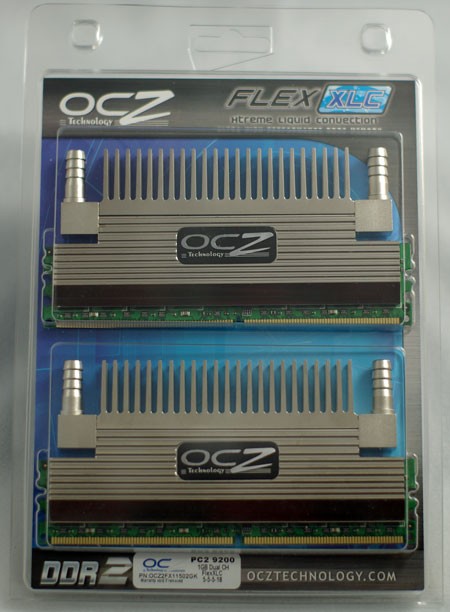
Quoting from OCZ literature the "Flex" in Flex XLC represents the "...innovative 'flexible' design, which gives enthusiasts the option to run these modules passively or water-cooled via the integrated liquid injection system for maximum heat dissipation."

The fin assembly was designed for very effective air cooling. When water is used even better cooling is possible. The hybrid copper and aluminum water channel and fin design is designed to cool effectively whether air or water is used for cooling. As the diagram indicates, water-cooling is optional.
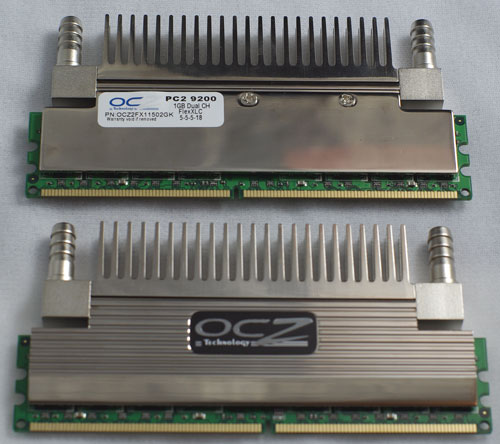
The Flex XLC DIMMs come ready for water hookup. The 3/8" entrance/exit nipples are an integral part of the cooling block and a standard design for water hoses. The flat top design of the heatsink/fins also makes it a "flat" surface for placing a large cooling fan over a pair or even four of these DIMMs. The Flex XLC dimms are thin enough that they can be fitted in side-by-side memory slots. We tried them on several boards and four dimms should fit just fine if you want to add even more memory. OCZ builds the new memory with specially binned Micron D memory chips mounted on an 8-layer PCB. The special binning, ultra low noise PCB, and hybrid heatsink design all contribute to overclocking capabilities.
| OCZ PC2-9200 Flex XLC Memory Specifications | |
| Number of DIMMs & Banks | 2 DS |
| DIMM Size | 1GB |
| Total Memory | 2 GB |
| Rated Timings | 5-5-5-18 at DDR2-1150 |
| Rated Voltage | 2.35V (2.4V +/- 5%) |
Flex XLC is currently only supplied as a 2GB kit (2x1GB) rated at PC2-9200 (DDR2-1150). This is the highest memory speed rating for DDR2 that we have ever tested. While Flex XLC is rated for 2.35V it is covered by the OCZ Extended Voltage Protection (EVP). This extension to the warranty provides a lifetime warranty against failure as long as the memory is operated at 2.52V or below.
While the form factor is new, it is worth repeating that OCZ is using specially binned Micron D memory chips in Flex XLC. That means the leading performance we routinely see with Micron memory chips should also be found in Flex XLC performance - along with the additional overclocking headroom designed into the product with aggressive binning and a hybrid cooling design.
Memory Test Configuration
We have recently been testing memory with the ASUS P5W-DH Deluxe, which is based on the Intel 975X chipset. We once again did all initial testing on that platform. The ASUS platform was used because the first generation of AM2 on-processor memory controller does not support any memory timings below 3, or memory speeds above DDR2-800. Both these features are supported on the ASUS motherboard. Timings of 2 are available for RAS-to-CAS and RAS Precharge, and DDR2-1067 is an available memory ratio.
In addition, it was clearly illustrated in Conroe vs. AM2: Memory & Performance that DDR2 memory performance, in timings and required voltage, are equivalent on the AM2 and Core 2 Duo platforms. However, with the evolution of the Intel P965 chipset, it is apparent that higher memory performance can be achieved with different memory "straps" used for the highest DDR2-1067 ratio setting. The P5W-DH Deluxe is very demanding of memory at high speeds, and the "looser" base ratios used at the top of most P965 boards allow higher memory overclocks with some memory modules.
This is another way of saying that the very best memory performs about the same on 975X and P965, but that we are aware of some DDR2 memory designs in the midrange that perform best on the P965. Recently the NVIDIA 680i chipset has demonstrated an even greater range of performance at the top of memory overclocking, with extremely flexible options for squeezing the most performance from almost any memory.
For all of these reasons, we revised test procedures for this memory review and memory reviews going forward. We first tested standard memory performance and overclocking on the ASUS P5W-DH Deluxe. This allows valid comparisons to earlier reviews of DDR2 memory on the Core 2 Duo platform. We then ran overclocking tests on the NVIDIA 680i test platform, using the same X6800 Core 2 Duo processor. We will continue this test procedure until we can fully evaluate the NVIDIA 680i as a potential replacement for the Intel 975X as our memory test platform.
The memory test bench uses the following components:
| Memory Performance Test Configuration | |
| Processor: | Intel Core 2 Duo X6800 (x2, 2.93GHz, 4MB Unified Cache) |
| RAM: | 2X1GB PCZ PC2-9200 Flex XLC (DDR2-1150) 2x1GB Patriot DDR2-1066 2x1GB Super Talent DDR2-1000 2x1GB Team DDR2-1000 2 x1GB Corsair CM2X1024-6400C3 2x1GB OCZ Ti Alpha PC2-8000 VX2 |
| Motherboards: | Asus P5W-DH Deluxe (Intel 975X) EVGA nVidia nForce 680i SLI |
| Hard Drive(s): | Hitachi 250GB SATA2 enabled (16MB Buffer) |
| Video Card: | 1 x EVGA 7900GTX - All Standard Tests |
| Video Drivers: | NVIDIA 91.47 |
| CPU Cooling: | Tuniq Tower 120 |
| Power Supply: | OCZ PowerStream 520W |
| Operating System(s): | Windows XP Professional SP2 |
What about the P965 as a memory test platform? We have also personally seen cases where the P965 on midrange memory performed much better than the 975X in memory speed, but where the P965 bandwidth was still the same or less than the 975X. On the very top memory, however, the P965 and 975X perform similarly. Since the ASUS P5W-DH Deluxe appears the more demanding platform we will continue testing base performance on the 975X.
However, a cross-section of enthusiast memory manufacturers were also asked which motherboard performed best with their top DDR2 memory. In all cases the answer that came back was the NVIDIA 680i motherboard. For that reason we have added the 680i to our tests of memory overclocking. Other alternatives will be evaluated for memory testing, but for now we will continue testing with the ASUS P5W-DH supplemented with the EVGA NVIDIA 680i tests for overclocking performance.
We recently have reviewed value DDR2-800 from both G.Skill and Super Talent. Results for those two memories are not included in comparisons in this review. For performance comparisons with those two memories you can refer to the linked reviews.
Stock Memory Performance
Most of today's motherboards that support DDR2 provide a wide range of memory ratios that match available DDR2 memory. End-users can select the memory ratio that matches their DDR2 memory speed. Our memory testing uses the same approach. We first test all of the stock ratios at the fastest stable timings we can achieve at the given ratio. With ratios, CPU speed remains the same at 2.93GHz in our memory test bed, and memory speed is varied by selecting different ratios.
The memory controller for Intel Socket T (Socket 775) motherboards is in the chipset, instead of part of the processor as in AM2 systems. Therefore, there is the potential for some memory performance anomalies. There is theoretically a small performance penalty for speeds other than a 1:1 ratio (DDR2-533 in this case) on boards designed for Intel processors. However, the actual performance penalty has been found to be very small with minimal impact on test results. As a result memory scales nicely through the various speed options.
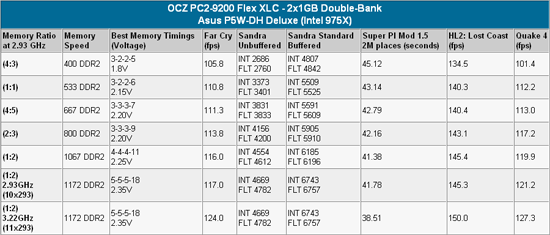 |
| Click to enlarge |
DDR2 memory is then pushed from the highest stock ratio that could be achieved in testing - in this case 1067 - to the highest FSB speed at the stock multiplier. A fortunate accident occurred in test results for the OCZ Flex XLC in that the highest stable memory speed on the P5W-DH of 1172 represents a base CPU speed of 293. By lowering the multiplier to 10 we were able to keep the overclocked memory test results at the same 2.93GHz processor speed. This allows easy comparison of test results at a very high memory speed at the same 2.93GHz. Results for the standard multiplier of 11 are also included at the bottom of the table. These are the results that should be compared to past DDR2 memory test results.
No matter how you slice it, the simple fact is that the OCZ Flex XLC, tested on air cooling, is the fastest DDR2 memory tested so far at AnandTech. DDR2-1172 exceeds the rated speed of DDR2-1150 on one of the most demanding boards available for testing DDR2 memory. To put this in perspective, the previous overclocking champion on this test bed reached DDR2-1116. Flex XLC, at DDR2-1172 is more than 5% faster than the previous best. With these results it was time to see where this memory could go on the new NVIDIA nForce 680i chipset - a chipset that had exhibited some stellar overclocks in our initial chipset launch review.
 |
| Click to enlarge |
On the nForce 680i the OCZ Flex XLC took DDR2 memory performance to a new gold standard. On Air Cooling, Flex XLC reached DDR2-1300 at the rated timings of 5-5-5-18. This is 150MHz above the aggressively rated speed of DDR2-1150 (PC2-9200). The DDR2-1300 speed would be rated at PC2-10400, making Flex XLC the first DDR2 memory to break PC2-10000 in our memory testing.
Memory Bandwidth Scaling
Memory bandwidth normally improves with increases in memory speed and reductions in memory timings. This is best illustrated using Performance Scaling charts instead of Bar charts for individual speeds.
Since the results for high-end memory are so close at all tested speeds, the scale range was reduced to better show the small differences in these memory benchmark results. Please keep this in mind when viewing the charts, since a normal zero scale would make performance differences appear much smaller than these expanded scale charts. Values for the tested DIMMs at each speed are included below each chart for reference.
To evaluate memory bandwidth SiSoft Sandra 2007 Professional was used to provide a closer look at scaling for fast DDR2 memory.
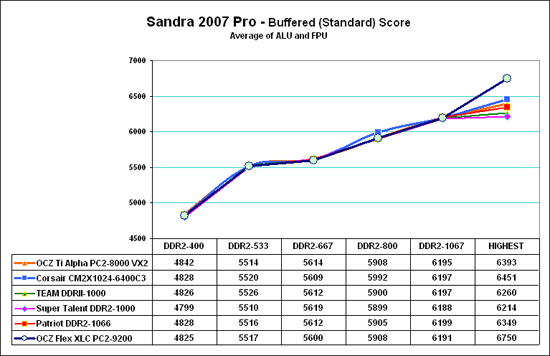
The most widely reported Sandra score is the Standard or Buffered memory score. This benchmark takes into account the buffering schemes like MMX, SSE, SSE2, SSE3, and other buffering tools that are used to improve memory performance. The Buffered benchmark does not correlate well with real performance differences in games, so our memory bandwidth tests have always included an Unbuffered Sandra memory score. The Unbuffered result turns off the buffering schemes, and we have found the differences in Unbuffered results correlate well with real-world performance differences.
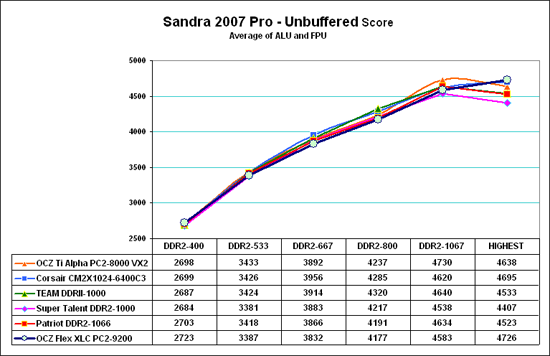
In both Buffered and Unbuffered tests we see the OCZ Flex XLC mirrors the best memory tested to DDR2-1066. This is exactly what would be expected since the Flex XLC is based on the same core memory chip as the other tested memories. Memory bandwidth increases dramatically at the top in buffered bandwidth (standard test). This is mostly a result of the much higher overclock in memory that could be achieved with the OCZ PC2-9200 Flex XLC compared to other Micron D-based memory. Unbuffered results also increase at the top speed, but not as dramatically as buffered results. This is also the expected result.
A look back at the page 4 tables will show that where we tested with the same CPU speed at the highest memory overclock the bandwidth increases at DDR2-1192 are smaller. The bandwidth increases at the default 2.93 GHz speed are strictly the result of increased memory speed, as CPU speed is eliminated as a variable.
We also compared results with Version 1.5 of Super Pi - comparing the time to calculate 2 million places of Pi at the different memory speeds. This benchmark measures pure number crunching.
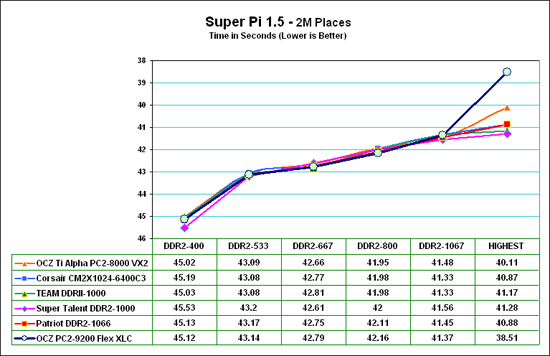
Super Pi results continue to improve all the way to the highest speed that could be reached with stability with each memory. The second result that stands out is how close the results with all the memories really are from DDR2-400 to DDR2-1066. This is mainly a reflection of the fact that compared memories are based on the same base Micron memory chips. At the highest speed Flex XLC pulls away from the pack with the record DDR2-1172 overclock. However, the 1172 top speed at stock 2.93 GHz is very close to DDR2-1067 results. These two results show the impact of CPU speed on calculation performance is much greater than the impact of memory speed increases.
Game Performance Comparison
Real-world benchmarks - specifically gaming benchmarks - provide the most useful measure of memory performance if you keep in mind what they represent. Memory is just one small part of overall gaming performance, and the AnandTech benchmarks keep everything the same except memory speed. Even the CPU speed is kept constant (except for the overclocking test). As a result performance improvements in FPS are very small because the only factor influencing the test results is memory speed. Many factors affect system performance, and memory speed is just one of those factors.
Results for high-end memory are very close at tested speeds. Therefore, the scale range was reduced to better show the small differences in these memory benchmark results at each speed. Please keep this in mind when viewing the charts. A normal zero scale would make performance differences appear much smaller than these expanded scale charts. Values for all tested memories at each speed are included below each chart for reference.
The AT memory test suite uses Far Cry, Half Life 2 and Quake 4 for memory testing because they are sensitive to memory performance.

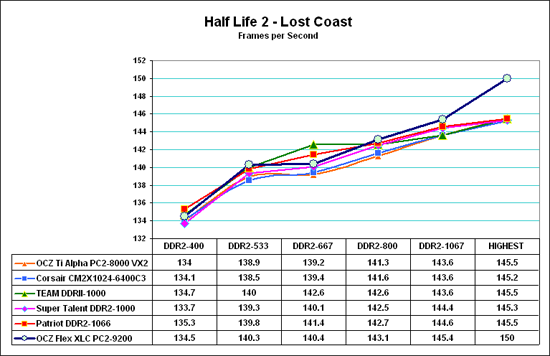

Despite the fact that memory is varying from 3-2-2-5 timings at DDR2-400 all the way to 5-5-5-18 timings at DDR2-1172 all three games continue to show improvement in frame rates as memory speed increases. Put another way, performance continues to improve as memory speed increases. This is the best evidence you will find to prove that increasing memory speed does increase performance - even to DDR2-1067 and beyond. The OCZ Flex XLC again mirrored performance of the other Micron-based memory until we reached the top speed. There it broke away from the pack, producing the highest game test results we have seen so far at the overclocked speeds. OCZ Flex XLC is a great performing memory. Even Air-Cooled the Flex XLC set new performance records in every test category, and there is still the promise of even better performance with water cooling.
Overclocking Performance (Highest Ratio at Highest Speed)
With the OCZ PC2-9200 Flex XLC rated at DDR2-1150, you are already at the highest overclock we have tested on DDR2 at the speed rating of the memory. It is noteworthy that The Flex XLC goes even further - to DDR2-1172 - on what is one of the most demanding motherboards for testing DDR2 memory. Performance of the aggressively binned Micron D9 memory chips proves the utility of binning for speed. OCZ Flex XLC is the fastest memory we have tested so far by a wide margin.
The timings required for a top DDR2-1172 were the rated 5-5-5-18 at 2.35V. These are certainly not glamorous timings compared to 3-3-3 at DDR2-800, but the fact remains that memory speed and performance still scaled well to the top speed.
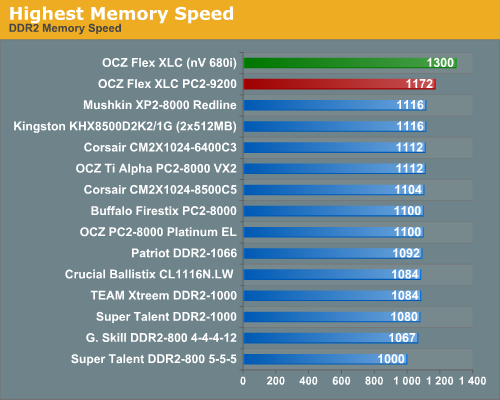
The NVIDIA nForce 680i motherboard allowed us to climb even higher. OCZ Flex XLC was stable at an unlinked CPU FSB of 1733 and a memory speed of DDR2-1300.
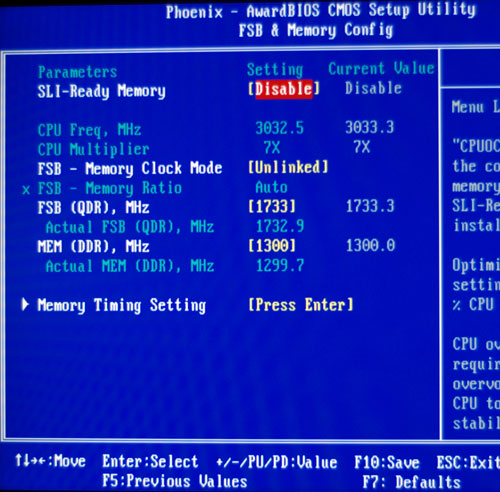
To get the CPU speed close to our stock test speed of 2.93 GHz, we lowered the multiplier to 7 at this 433 base. This yielded a CPU speed of 7x433 or 3.03 GHz. Memory at this speed was a stable DDR2-1300.
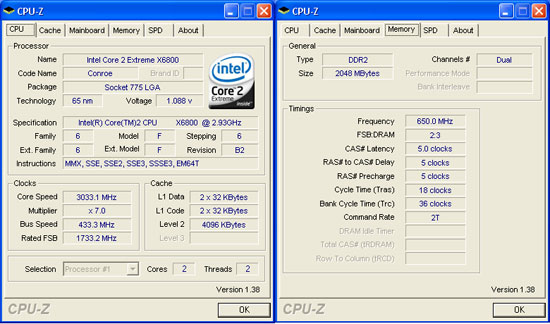 |
| Click to enlarge |
Comparing test results to those from the ASUS 975X test platform will show you faster results with the ASUS. This is a result of the 3.22GHz speed of the ASUS at the top compared to 3.093GHz top speed on the 680i. If you refer back to the performance charts on page 3 you will find performance numbers at DDR2-1172 at 2.93GHz. Comparing those to the 680i performance results shows performance data in line with the speed expectations.
The OCZ PC2-9200 Flex XLC topped the overclocking chart by a wide margin. Performance was impressive on the P5W-DH at DDR2-1172, but it was even more outstanding on the 680i at DDR2-1300.
Final Words
In a recent memory review we commented that the best DDR2 memory in the market is able to run at DDR2-800 3-3-3 timings and DDR2-1066 at 4-3-4. OCZ PC2-9200 Flex XLC has not changed the performance dynamics at those speeds. It is still based on Micron D9 memory chips, and in fact it requires 4-4-4 timings at DDR2-1067 due to the aggressive binning for the top speed. OCZ Flex XLC is not a new record setter at the useful speeds of DDR2-800 and DDR2-1066 - or the speeds of 400, 533 or 667.
OCZ Flex XLC does break new ground, however, at the top. Flex XLC demolishes our old overclock record of 1116 on the ASUS P5W-DH by almost 5% - reaching a stable memory speed of DDR2-1172. Performance is even more compelling on the NVIDIA nForce 680i, where Flex XLC reaches DDR2-1300!
These new performance records were set on air cooling, so there is still more headroom left with XLC. It comes equipped with a copper/aluminum water block heatsink, which is ready to be connected to a water cooling system with the integrated 3/8" nipples. Since we have not really covered water-cooling in the past we decided it was best not to report water-cooling results here in the AT review. However, there is a bit more headroom with water, and those using water cooling can expect even better results.
We were really skeptical when OCZ told us this was a "flexible" memory - a record-setter on either air or water cooling. Now that we have run OCZ PC2-9200 Flex XLC through our test suite we definitely agree. Flex XLC will perform very well in your system even if water never comes near it; if you use water cooling you may get even more. On air only, Flex XLC has set new overclocking records.
As with most other components, the best does not come cheap. A 2 GB kit of OCZ Flex XLC will set you back about $490 with the introductory rebate. This is more than twice what value DDR2 will cost you, but the price is definitely in the ballpark with other top DDR2 memory. We have said in recent reviews that Core 2 Duo and AM2 are not particularly bandwidth sensitive. As a result we have recommended that value shoppers go for value and midrange DDR2 parts and put the savings in a video card or CPU upgrade. If you look strictly at performance gains with Flex XLC it will be hard to justify the price on performance increases alone.
However, looking at just performance numbers misses the point with OCZ Flex XLC. A board like the NVIDIA 680i has options to go to overclocks we never thought would be possible on the Core 2 Duo. A memory like OCZ Flex XLC allows you to go further in overclocking, with fewer restrictions, than any other memory we have tested so far at AnandTech. If you are a dedicated overclocker OCZ Flex XLC is a must-have product. If you want the best memory performance possible in your system the Flex XLC is the best. However, if you prefer to measure every component by a "bang-for-the-buck" formula then pass on Flex XLC, buy a value or mid DDR2-800 rated at least DDR2-800 and put the savings in a video card or CPU upgrade.
It is good to see some real innovation the DDR2 memory market, and OCZ should be congratulated for shaking things up with a water-cooling ready retail product. It was also smart of OCZ to ensure that the product would blow away even those users who use regular air cooling. Corsair has also recently introduced a couple of really innovative DDR2 memory products that we will be looking at in our next DDR2 review. It will be interesting to see if OCZ stands alone or whether the day of aggressively binned and record-setting DDR2 products is just dawning.
Mad overclockers will love OCZ PC2-9200 Flex XLC. Water-cooling enthusiasts will add Flex XLC to their wish list. Performance fans will want the flexibility of a top DDR2-1300 memory speed. However, those shopping for value per dollar memory are shopping in the wrong category.







